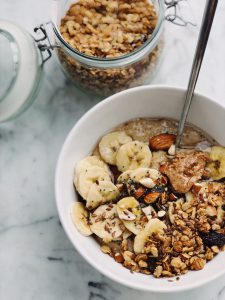As anxiety, depression, and other mental health issues are on the rise, people are seeking natural, holistic ways to help relieve their day-to-day blues. Of course, you should always talk to a trusted doctor if you have serious concerns, but some people are able to manage their emotional ups-and-downs with coping mechanisms, like journaling. Adopting a journaling practice, like bullet journaling, is a great way to process emotions, prioritize and organize your life, and track everything from your successes to your mental health symptoms.
Benefits of Journaling

There are many studies that use a journaling practice as an intervention strategy for mental health issues like anxiety, trauma, or depression, as well as for those in high-stress situations, like college students, children in foster care, and families experiencing homelessness. Bullet journaling, like any journaling practice, has many benefits. Journaling has been proven to effectively:
- Improve your mood
- Enhance your sense of well-being
- Reduce symptoms of anxiety and depression
- Reduce symptoms of intrusive thoughts and avoidance that are related to traumatic events
- Improve memory and focus
A regular journaling practice positively impacts experiences of stress and anxiety by allowing you to:
- Relax and clear your mind
- Release feelings about anxieties and everyday stress
- Write about struggles and successes
- Focus on gratitude
- Enhance self-awareness and awareness of triggers
- Track progress
- Organize things big and small and plan for multiple outcomes and scenarios.
These studies also show that the consistency and regularity of your journaling practice is key. A 2013 study found that expressive writing on any topic, from deepest, emotional thoughts to a simple daily event, for 20 minutes a day, three days a week, saw a significant decrease in symptoms of depression. It’s believed that journaling helps create a positive mindset by allowing you to confront negative emotions, focus on positive emotions, and organize a productive response. Writing in your bullet journal – one created by you, for you – is a great step toward a healthy mindset, and can provide you with valuable insight to better understand your own mental health.
What Is Bullet Journaling?
Bullet Journaling, or “BuJo”, is a specific type of journaling that is a creative mix of planner-meets-diary. With some traditional journals, you fill in predetermined boxes for each day, week, month or year. A bullet journal is simply a blank journal that you create on your own. The beauty of bullet journaling is that, because it is entirely your creation, you can get as detailed, artistic, and organized as you want! You can do this freehand or by following stencils – there are many blogs and accounts on Instagram and Pinterest dedicated to BuJo layouts. With a bullet journal, you have the flexibility to choose what you are tracking, logging, and writing about. Some section ideas include:
Daily:
- Mental health symptoms: Tracking your mood, anxiety, and mindset each day can help you to recognize patterns and triggers. Some therapists recommend this practice to help provide a framework for discussion in therapy sessions.
- Physical symptoms: Many mental health issues have comorbid physical symptoms, like headaches, lethargy, and an upset stomach. Logging these symptoms can help uncover patterns that you can address with a professional.
 Sleep logging: Tracking how many hours and the quality of sleep you are getting is important! Studies suggest that as much as 70% of the population doesn’t get enough high-quality sleep. Being tired exacerbates preexisting mental health conditions and sets you up for a long, stressful day, so it’s helpful to be aware of your sleeping habits.
Sleep logging: Tracking how many hours and the quality of sleep you are getting is important! Studies suggest that as much as 70% of the population doesn’t get enough high-quality sleep. Being tired exacerbates preexisting mental health conditions and sets you up for a long, stressful day, so it’s helpful to be aware of your sleeping habits.- Food tracking: Logging what you are eating and how it makes you feel is an important step toward a healthy relationship with food. Food tracking also helps you to focus on enjoying your food, and can bring a sense of mindfulness to your meals.
- Gratitude: Psychologists recommend a gratitude list as a critical way to build a positive mindset. By reflecting on what you are grateful for, you can train your brain to build positive associations and look for the good in things. Keeping a gratitude list in a BuJo that you look at often is an easy way to make this reflection a part of your daily routine.
Weekly:
- Meal prep and grocery lists: Keep your lists and plans organized alongside your food tracker, building off of what meals you enjoyed and how they made you feel.
- Chores, appointments, and to-do lists: Some of us rely heavily on lists to stay organized! Keeping them in one central location, rather than scattered throughout the house on scraps of paper, will help you tackle those to-do lists. Having these lists can also ease any anxiety you have about planning for the week, and making sure you haven’t forgotten anything.
Monthly:
- Important dates like deadlines and birthdays: When you’re feeling overwhelmed by mental health symptoms, or even just daily life, it is easy to lose track of important dates. Keeping your calendar in one central location that you look at frequently, like your BuJo, helps avoid the stress of a forgotten appointment.
- Monthly cleaning calendar: Our home space is a reflection of our headspace! Use a monthly cleaning calendar to make your home feel less cluttered and more peaceful.
- Budget tracking: Use this to track spending and plan finances. Financial stressors are a major burden, and having an organized log and plan helps many people breathe breathe easier.

Other sections:
- Words of affirmation: Used to inspire and uplift yourself when you’re feeling down
- Self care strategies: Reminders of what you can do to relax and reset
- Coping mechanism toolkit: Strategies to use when mental health symptoms are acting up
- Page of wins: Logging victories, big and small, to reflect on when things seem hopeless.
- Hobbies: Some people track how many books they’ve read, chart their plants’ growth, log their song-of-the-month, or note new recipes they’ve tried and loved. It can be inspiring to look back and remember things you love!
Remember that your bullet journal is yours! Nobody is judging how professional it looks or what you’re choosing to track. Fill it with things that are important to you or that bring you joy, and it can be a useful tool for staying organized and staying positive.
Getting Started
Even if you’re not actively experiencing any mental health issues, building a consistent journaling practice can only serve to support your emotional wellbeing. The best part is, you can probably start right now with just the things you have at home. But, if you choose to invest a little more in this routine, there are a few must-have materials. 
- The right journal: People swear by Moleskine’s dotted journal, but any journal with grids or dots will work – or even blank pages, if you’re talented!
- The right pens: This is a matter of personal preference. Some people use their standard Bic pen or Crayola markers, and others choose to invest in higher quality calligraphy pens. Pick what suits your needs – you might have a few favorites that you use for different writing styles.
- The extras: There are a multitude of BuJo extras available for purchase – stickers, washi tape, tabs, and more. Use whatever you need to help keep yourself organized and to keep your journaling fun!
Once you’ve gathered materials, you can turn to the many pages of inspiration on Pinterest and Instagram dedicated to creative bullet journaling layouts. It’s up to you to decide what to prioritize. You can build your BuJo around tracking mental health and habits, or you can start off with a page of affirmations and gratitude. You’ll probably want a mix of tracking collections, positive reminders (like the affirmations and gratitude), and then your weekly, monthly, and yearly planning sections. You are the author of this personalized planner, so you get to decide what goes where! There are many inspiring social media accounts and blogs dedicated to BuJos, but ultimately it has to work for you. So dive in, get creative, and see the benefits right away!
